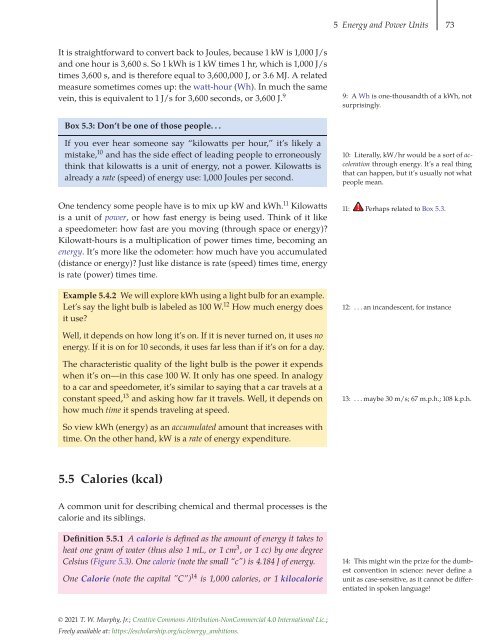Energy and Human Ambitions on a Finite Planet, 2021a
Energy and Human Ambitions on a Finite Planet, 2021a
Energy and Human Ambitions on a Finite Planet, 2021a
Create successful ePaper yourself
Turn your PDF publications into a flip-book with our unique Google optimized e-Paper software.
5 <str<strong>on</strong>g>Energy</str<strong>on</strong>g> <str<strong>on</strong>g>and</str<strong>on</strong>g> Power Units 73<br />
It is straightforward to c<strong>on</strong>vert back to Joules, because 1 kW is 1,000 J/s<br />
<str<strong>on</strong>g>and</str<strong>on</strong>g> <strong>on</strong>e hour is 3,600 s. So 1 kWh is 1 kW times 1 hr, which is 1,000 J/s<br />
times 3,600 s, <str<strong>on</strong>g>and</str<strong>on</strong>g> is therefore equal to 3,600,000 J, or 3.6 MJ. A related<br />
measure sometimes comes up: the watt-hour (Wh). In much the same<br />
vein, this is equivalent to 1 J/s for 3,600 sec<strong>on</strong>ds, or 3,600 J. 9<br />
9: A Wh is <strong>on</strong>e-thous<str<strong>on</strong>g>and</str<strong>on</strong>g>th of a kWh, not<br />
surprisingly.<br />
Box 5.3: D<strong>on</strong>’t be <strong>on</strong>e of those people. . .<br />
If you ever hear some<strong>on</strong>e say “kilowatts per hour,” it’s likely a<br />
mistake, 10 <str<strong>on</strong>g>and</str<strong>on</strong>g> has the side effect of leading people to err<strong>on</strong>eously<br />
think that kilowatts is a unit of energy, not a power. Kilowatts is<br />
already a rate (speed) of energy use: 1,000 Joules per sec<strong>on</strong>d.<br />
10: Literally, kW/hr would be a sort of accelerati<strong>on</strong><br />
through energy. It’s a real thing<br />
that can happen, but it’s usually not what<br />
people mean.<br />
One tendency some people have is to mix up kW <str<strong>on</strong>g>and</str<strong>on</strong>g> kWh. 11 Kilowatts 11: Perhaps related to Box 5.3.<br />
is a unit of power, or how fast energy is being used. Think of it like<br />
a speedometer: how fast are you moving (through space or energy)?<br />
Kilowatt-hours is a multiplicati<strong>on</strong> of power times time, becoming an<br />
energy. It’s more like the odometer: how much have you accumulated<br />
(distance or energy)? Just like distance is rate (speed) times time, energy<br />
is rate (power) times time.<br />
Example 5.4.2 We will explore kWh using a light bulb for an example.<br />
Let’s say the light bulb is labeled as 100 W. 12 How much energy does<br />
it use?<br />
12: ...aninc<str<strong>on</strong>g>and</str<strong>on</strong>g>escent, for instance<br />
Well, it depends <strong>on</strong> how l<strong>on</strong>g it’s <strong>on</strong>. If it is never turned <strong>on</strong>, it uses no<br />
energy. If it is <strong>on</strong> for 10 sec<strong>on</strong>ds, it uses far less than if it’s <strong>on</strong> for a day.<br />
The characteristic quality of the light bulb is the power it expends<br />
when it’s <strong>on</strong>—in this case 100 W. It <strong>on</strong>ly has <strong>on</strong>e speed. In analogy<br />
to a car <str<strong>on</strong>g>and</str<strong>on</strong>g> speedometer, it’s similar to saying that a car travels at a<br />
c<strong>on</strong>stant speed, 13 <str<strong>on</strong>g>and</str<strong>on</strong>g> asking how far it travels. Well, it depends <strong>on</strong><br />
how much time it spends traveling at speed.<br />
13: ...maybe30m/s; 67 m.p.h.; 108 k.p.h.<br />
So view kWh (energy) as an accumulated amount that increases with<br />
time. On the other h<str<strong>on</strong>g>and</str<strong>on</strong>g>, kW is a rate of energy expenditure.<br />
5.5 Calories (kcal)<br />
A comm<strong>on</strong> unit for describing chemical <str<strong>on</strong>g>and</str<strong>on</strong>g> thermal processes is the<br />
calorie <str<strong>on</strong>g>and</str<strong>on</strong>g> its siblings.<br />
Definiti<strong>on</strong> 5.5.1 A calorie is defined as the amount of energy it takes to<br />
heat <strong>on</strong>e gram of water (thus also 1 mL, or 1 cm 3 , or 1 cc) by <strong>on</strong>e degree<br />
Celsius (Figure 5.3). One calorie (note the small “c”) is 4.184 J of energy.<br />
One Calorie (note the capital ”C”) 14 is 1,000 calories, or 1 kilocalorie<br />
14: This might win the prize for the dumbest<br />
c<strong>on</strong>venti<strong>on</strong> in science: never define a<br />
unit as case-sensitive, as it cannot be differentiated<br />
in spoken language!<br />
© 2021 T. W. Murphy, Jr.; Creative Comm<strong>on</strong>s Attributi<strong>on</strong>-N<strong>on</strong>Commercial 4.0 Internati<strong>on</strong>al Lic.;<br />
Freely available at: https://escholarship.org/uc/energy_ambiti<strong>on</strong>s.


















